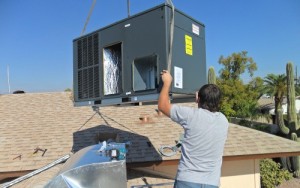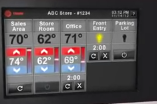Has Your Mesa Home Installed Air Conditioning Exceeded A Useful Lifespan
 Survey Reveals Performance-Deficiency As Primary Cause For Installed Air Conditioning Residential Replacement
Survey Reveals Performance-Deficiency As Primary Cause For Installed Air Conditioning Residential Replacement
In a recent survey of 492 HVAC contractors, researchers established a 12-14 year average replacement cycle for residential air conditioning systems. The study also showed that many homeowners opted to replace the existing system before the product reached end-of-life usefulness. In most cases the decision for early AC replacement came about due to a perception that the cooling capacity and cost of unit operation was in excess of the homeowner’s expectations (1).
End conclusion: The efficiency of AC system performance plays a major role in how homeowners evaluate the useful life of a residential air conditioning system.
Efficient Evaporator Air Flow: Key Factor In Arizona Air Conditioning Performance
According to the Energy Star central air conditioner overview report, reaping the full benefits of an Energy Star certified heating and cooling system also requires that you “take steps to optimize” the practical performance of the system (2). In other words: even when a homeowner installs a new energy-efficient central A/C, successfully achieving an increase in performance depends on the skill, knowledge and applied principles of the HVAC installation crew.
One might think that proper installed air conditioning comes with the turf. Alas, this may not reflect actual conditions. The FCC survey included field tests of 70 residential A/C systems in Arizona as well as field tests of 27 systems in central California. In both test cases, the performance of the examined units failed to meet the system manufacturer’s declared Energy Efficiency Ratio (EER). Of the 70 units tested in Arizona, the average performance deficiency came in at 40% lower than the EER rating for the given unit.
Primary cause for underperformance: Insufficient airflow across the evaporator coil.
Adequate Air Flow Critical To Efficient A/C EER Returns
Conventional air conditioning units perform two primary functions:
- 1) Sensible Cooling… The effective process of cooling the air
- 2) Latent Cooling… The effective process of removing moisture from the air.
Reliable residential installed air conditioning (IAC) performance is primarily dependent on a balance between moisture removal and sensible heat transfer. This can only be achieved when the unit functions with ample air flow across the evaporator coil. The technical aspects involved in A/C installation and management of air handler fan speed, load requirements and airflow control exceed the limits of this article. However defining the consequences of miss-applied system installation is simple:
- If the airflow over the coil is too high, the system is compromised. Moisture removal falls short, and fan power gets elevated.
- If the airflow is too low, reduced system cooling occurs, and the system EER falls short. Furthermore: Extreme hindrance of airflow can cause icing of the evaporator coil. Likewise: Continuous problems with icing can lead to refrigerant flood-back. End result may even include early failure of the system compressor.
The dry Arizona climate typically equates to a low latent/humidity factor. When a Mesa home A/C system is correctly installed, years of maximum-performance efficiency become readily possible. Furthermore, if a home system is not aged-out but is rather suffering from major installation problems, correcting the errors can effectively restore new life to an older air conditioning unit. In essence, if your new energy-efficient home air conditioning system is incorrectly installed, it may actually perform nearly as badly as your aged and inefficient replaced unit.
Tips From American Cooling and Heating For Avoiding Poor AC Performance
It may be that your failing home cooling system is merely the consequence of a poorly installed unit. Or perhaps, time has played a role in the lack of adequate system performance. External conditions can change, wherein new obstacles now hinder the airflow to your external condenser unit. Duct sealant can fail and cause air leaks. Even in-duct grime can be a problem. Before discounting the efficiency of your Mesa home air-conditioning system, consider the steps of proper AC installation as listed below. An American Cooling and Heating home AC checkup can answer all of your questions, and if a new unit becomes the preferred solution, ACH will ensure that your system is correctly and effectively installed.
The following list offers no specific order, but the principles for correctly installing or configuring an air conditioning system remain true even if the system is aged. When installing a new HVAC system, American Cooling and Heating air conditioning technicians:
- Allow ample indoor room for installation and future system servicing
- Before positioning condensing unit, consider the noisy factor on neighbors as well as home occupants
- Install sufficient air return and cool air delivery registers
- Position condensing unit in an area free of objects that can create hindrance to airflow
- Position system thermostat(s) for most effective heating and cooling response to home conditions
- Prior to system installation, apply reliable duct-sizing tactics
- Properly insulate attic ducts
- Provide an access path cleaning the evaporator coil via a door into the duct or the furnace
- Use effective and product-recommended duct sealing components
- Verify correct and exact refrigerant charge
- Verify that unit meets manufacturer-specified airflow rate
- When possible, install ductwork inside the region of air-conditioned space.
Be your AC old or be it new, the ACH team is ready to help you get the most bang for your heating and cooling buck. Call us now!
1) FSEC “Impact of Evaporator Coil Air Flow in Residential Air Conditioning Systems“
2) Energy Star, Central Air Conditioning Overview




